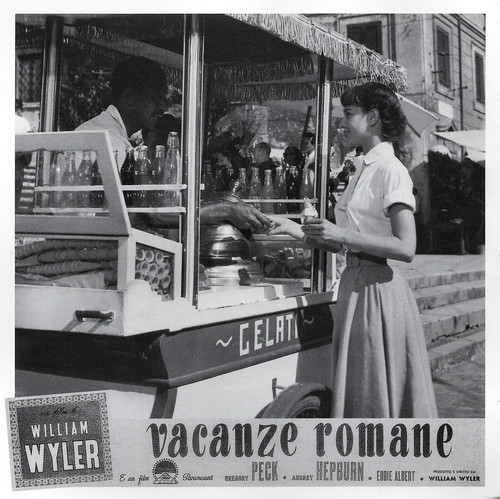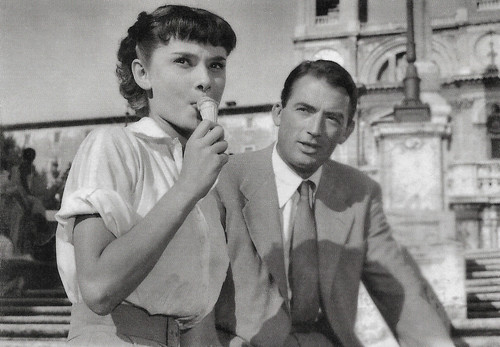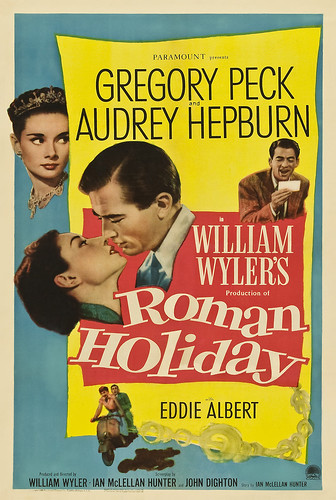
German postcard by Kunst und Bild, Berlin, no. A 1031. Photo: Paramount. Audrey Hepburn in Roman Holiday (William Wyler, 1953).

German postcard by Kunst und Bild, Berlin, no. A 1079. Photo: Paramount. Audrey Hepburn and Gregory Peck in Roman Holiday (William Wyler, 1953).

Dutch postcard by Takken / 't Sticht, Utrecht, no. 1469. Photo: Paramount. Audrey Hepburn in Roman Holiday (William Wyler, 1953).
Having a wonderful, romantic time together
Audrey Hepburn plays Princess Ann, a young princess who is on an exhausting tour of European capitals with her entourage. This is how she ends up at the embassy in Rome. She is tired and she is fed up with all the handshaking and all the formalities. In the evening, she rebels against protocol. Her doctor gives her an injection of a sedative after which she is left in her room. She manages to escape through the window.
In the nightly streets of Rome, she is found on a bench by Joe Bradley (Gregory Peck), a single American journalist living in the city for a while. First, he tries to get her in a taxi towards her house and when that fails, he takes her to his own house, to stay the night at his place.
Only the next day at the newsroom does he realises who he has actually brought into his house. With this great scoop in his hands, he persuades her into a fun 'day of doing nothing' with him. They do all the things that 'normal people' think are ordinary, but are special for a princess. Like going out on a terrace, riding a scooter around town and going to a dance night. During their outing, everything is photographed by Irving Radovich (Eddie Albert), a photographer friend. He uses a mini camera hidden in a lighter for this purpose.
Ann and Bradley are having a wonderful, romantic time together, but how long can it last? When Ann realises that her country is in trouble because of her sudden absence, she decides to return and carry out her duties. The next day, she gives a press conference to talk about her visits. She is advised to say she liked all the cities equally, but steps away from that protocol and calls Rome her best experience. She is surprised to see Joe in the room and is shocked to see Irving taking pictures with his lighter.
In the end, Irving and Joe offer her an envelope with a memento of the city, which contains the photos. Ann understands that their secret will remain secret. In her speech, Ann then says how grateful she is for her beautiful stay in town, but Joe clearly hears in this a packaged message of gratitude to him. Both realise that they feel a lot for each other, but that their love is doomed to remain unfulfilled.

Italian postcard by W. Di Giovanni. Photo: Augusto Di Giovanni. Gregory Peck in Roman Holiday (William Wyler, 1953).

Italian postcard by W. Di Giovanni. Image: Italian lobby card by Paramount with a photo by Augusto Di Giovanni. Audrey Hepburn in Roman Holiday (William Wyler, 1953).
Bitten by the Mouth of Truth
Director Frank Capra toyed with the idea of Roman Holiday back in 1949. It was to be a variation on his successful film It Happened One Night (1934), but this time starring Cary Grant and Elizabeth Taylor. But Capra's production company Liberty Films was in financial trouble after the flop of It's a Wonderful Life. Capra sold Liberty to Paramount Pictures, where screenwriter Dalton Trumbo went to work on the screenplay. Capra withdrew from the film when it turned out that the budget for the film was too tight.
Paramount then sought George Stevens as director, but he also saw little in the production, after which William Wyler was approached. Wyler who had just directed two heavy dramas, The Heiress (1949) and Detective Story(1951), was happy with this lightweight comedy. Wyler suggested to Paramount to shoot the film in Italy. After all, he had no desire to appear before the House Un-American Activities Committee, which was investigating communist infiltration of the film industry and wanted to be far away from Hollywood. It was therefore a wry coincidence that the screenplay's writer, Dalton Trumbo had been blacklisted by the same House Un-American Activities Committee. Trumbo was one of the Hollywood Ten, a group of screenwriters who were banned from working in Hollywood because of alleged communist sympathies.
For this reason, Trumbo's name does not appear in the credits, nor could he receive the Oscar for Best Screenplay. His friend Ian McLellan Hunter got the credits and the Oscar. It was not until 1993 that the widow of Trumbo, who died in 1976, was finally awarded the Oscar. Paramount was initially not happy with the proposal to shoot the film on location. They wanted to shoot everything at the studio in Hollywood. They eventually relented, partly because Paramount could use frozen assets in Europe. However, Wyler was told that the budget was going down and the film had to be shot in black-and-white. With a budget of one and a half million dollars, Wyler went to work.
Initially, Cary Grant had been tapped for the male lead. However, Grant felt too old for the role and he renounced the film. Gregory Peck was interested though, especially since Roman Holiday was a comedy, and Peck had wanted to be in such a film for years. For the role of Princess Ann, they originally had Elizabeth Taylor in mind. However, director William Wyler wanted Jean Simmons for the role. When Simmons was not available, Wyler wanted to cancel the whole project. However, the studio went ahead and the next person approached was Suzanne Cloutier. However, she was also taken. More actresses were tested, but eventually, the role went to the then virtually unknown Audrey Hepburn, despite the fact that her test shot was actually a failure. She acted far too stiff and unnatural. After the audition, however, the camera kept rolling and recorded a relaxed Hepburn who stood talking enthusiastically to the director. It was this 'performance' that ensured Hepburn got the role.
Shooting in Rome was not always easy. It was extremely hot that summer with temperatures exceeding 35 degrees. The heat also rose to the heads of Rome's residents and strikes broke out regularly and film production suffered considerably. Filming was done without cordoning off streets and with the general public as casual extras. On the other hand, there were also fewer casual extras. Members of the Italian nobility figured at the Ambassador's ball (they donated their wages to charity) and members of the real press attended the press conference.
Among all the veterans like Peck and Wyler, debutante Hepburn struggled to find her way. During a take, for instance, she could not produce the tears she wanted. Take after take, the now boiling Wyler spent on his leading actress. He screamed his anger at all the failed shots, to which Hepburn burst into tears. Wyler immediately ran the camera and the scene was on. Gregory Peck had his own method of pulling Hepburn along. When shooting at the Mouth of Truth, Peck's character, Joe, had to put his hand in the mouth of a statue. According to legend, the mouth would bite the hand off if he was a liar. Wyler was keen to get a natural scare reaction from Hepburn and Peck helped him do that. The moment he withdrew his hand he gave a cry of pain and retracted his hand into the sleeve of his jacket. Hepburn knew nothing and her look of horror and surprise was genuine, as was the scream of terror that escaped her. Wyler could be satisfied, he only needed one take.

French postcard by Editions Art & Scène, Paris, no. CA 94, 1995, 1995. Photo: Paramount. Audrey Hepburn and Gregory Peck in Roman Holiday (William Wyler, 1953).

Italian postcard. Photo: Paramount. Audrey Hepburn and Gregory Peck in Roman Holiday (William Wyler, 1953).

Postcard. Poster for the Paramount film Roman Holiday (William Wyler, 1953).
Sources: Rialto VU, Wikipedia (Dutch) and IMDb
No comments:
Post a Comment